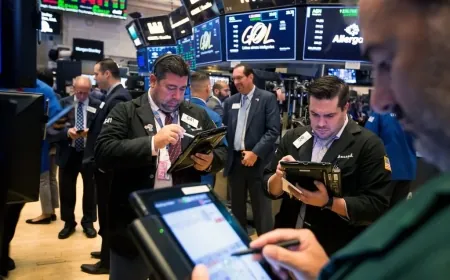S&P 500 and Nasdaq React to Economic Data, Shaping Rate-Cut Expectations
Services Sector Weakness Spurs Rate-Cut Bets Despite Strong Jobs Data

The S&P 500 and Nasdaq responded to economic signals, with the services sector's weakness shaping expectations of interest-rate adjustments. Despite robust jobs data, traders reevaluated forecasts, leading to increased odds of a March rate cut.
Economic Signals Impact Stocks
In a dynamic market session, the benchmark S&P 500 and the Nasdaq experienced fluctuations following the release of economic data. The market responded to signals from the services sector, influencing expectations of interest-rate adjustments in the coming months. This shift came shortly after robust jobs data had tempered earlier predictions of rapid easing.
Sector Performance
Financial stocks and major tech companies played a pivotal role in driving market gains. Notable performers included Bank of America and JPMorgan Chase in the financial sector, alongside tech giants Amazon.com, Nvidia, and Microsoft. Their collective impact ranged from 0.5% to 2.7%.
ISM Survey Insights
An Institute for Supply Management (ISM) survey indicated a dip in services sector activity, accounting for more than two-thirds of the economy. The December figure of 50.6, down from the previous month's 52.7, prompted a reassessment of economic conditions. Economists, anticipating a reading of 52.6, were taken by surprise.
Interest Rate Expectations
The yield on the benchmark U.S. Treasury 10-year note, reflecting interest rate expectations, initially rose but later adjusted following the ISM data. It settled at 3.998%, underlining the market's sensitivity to economic indicators.
March Rate-Cut Odds
Contrary to initial expectations of a slower pace of rate cuts, traders now envision a 71% chance of at least a 25-basis point cut in March. This marks an increase from nearly 55% earlier in the day, as indicated by the CME Group's FedWatch tool.
Market Response and Expert Commentary
Financial stocks led gains among the S&P 500 sectors, achieving a 0.6% advance and reaching a over 1-1/2-year high. Thomas Hayes, Chairman at Great Hill Capital, highlighted the nuanced employment data and lower-than-estimated ISM non-manufacturing figures, suggesting that Fed cuts might occur sooner than anticipated.
Weekly Performance and Sector Rotation
Despite the day's positive shifts, both the S&P 500 and Nasdaq were still on track for their worst weekly performances since late October and late September, respectively. The week saw investors capitalizing on profits after a nine-week winning streak, triggering a rotation out of tech-heavy stocks into defensive sectors such as healthcare, financials, and utilities.
Market Snapshot
As of midday, the Dow Jones Industrial Average was up 0.08%, the S&P 500 gained 0.39%, and the Nasdaq Composite rose by 0.43%. Notable stock movements included a significant drop of 36.8% for Applied Therapeutics and a 2.1% decline for Palantir Technologies following a downgrade by Jefferies.
Key Partnerships and Future Outlook
Peloton experienced an 11.1% surge after announcing an exclusive partnership with TikTok to bring its workout content to the short-form video platform. Investors remained attentive to remarks by Richmond Fed President Thomas Barkin, a key figure in shaping monetary policy.
Market Dynamics
Advancing issues outnumbered decliners on both the NYSE and Nasdaq, with ratios of 2.21-to-1 and 1.16-to-1, respectively. The session saw the S&P index recording 12 new 52-week highs and no new lows, while the Nasdaq recorded 33 new highs and 52 new lows.
Also Read: Investors Start 2024 with Record $123 Billion Cash Shift: Bank of America Report






























































